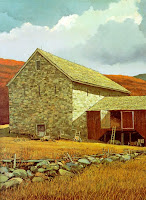Bill has a camp uplake from us. Whenever he comes calling he compliments me on the improvements I've made to our cabin. Bill is a retired pattern-maker and is amazingly handy himself. His own camp predated the road so he had to mule his building materials in on his back, on a sled or by boat. Having no electricity (still doesn't) he built his camp without benefit of power tools. I value his opinions and suggestions.
 On one visit he asked if I'd ever read anything written by Eric Sloane. I had not. He then loaned me his well-read copy of 'Diary of an Early American Boy'. I devoured the book and have since bought every Eric Sloane book I can find.
On one visit he asked if I'd ever read anything written by Eric Sloane. I had not. He then loaned me his well-read copy of 'Diary of an Early American Boy'. I devoured the book and have since bought every Eric Sloane book I can find.In addition to his obvious talents and work ethic, Sloane repeatedly benefited from being in the right place at the right time. In that way his early life reminds me of Forrest Gump. Sloane took an early interest in art. He learned how to draw numbers and letters from a neighbor, Mr. Goudy (designer of the popular Goudy font) and started painting signs for money. Living near Roosevelt Field on Long Island, he painted the names and numbers on many planes and got to know many of the pilots. He learned to fly from none other than aviation pioneer Wiley Post, the first pilot to fly solo around the world. He quickly became obsessed with the sky and clouds, themes that would become central to his art. His first cloud painting was bought by none other than Amelia Earhart and another covers an entire wall at the Smithsonian Air and Space Museum.
At age fourteen Sloane ran away to become an itinerant sign painter. He worked his way across America, painting signs on barns, buildings and stores. He studied America from a vantage point few people experienced.
Fascinated by weather, The Farmer's Almanac and the early American farmer's ability interpret "weather signs", Sloane is credited with being the first television weatherman, having come up with the idea of having farmers from all over New England call in their weather observations to a Dumont, New York TV station where they could be broadcast to the regional audience.
 Over the course of his eighty years, Sloane wrote thirty-eight books and created nearly 15,000 paintings.
Over the course of his eighty years, Sloane wrote thirty-eight books and created nearly 15,000 paintings.In the early 1950's, while restoring an antique farmhouse in Connecticut, he discovered a boy's almanac, inkwell and diary dated 1805. The contents piqued his interest in the life of early American settlers. By adding commentary and illustration, the diary provided the framework for the book Bill loaned me, 'Diary of an Early American Boy: Noah Blake 1805'.
While he may be best known for his paintings, it's his fascination with the lifestyle and ingenuity of early settlers that appeals to me. He is a recognized authority on Early American rural architecture, tools, folk wisdom and meteorology. Through his paintings and his books, Sloane's spirit lives on today as if he's determined to keep the invincible Early American Spirit alive. For this I will always be grateful to Eric Sloane and my thoughtful neighbor, Bill.
For a list of Sloane's books, go to www.townsendbooks.com/sloane.htm






No comments:
Post a Comment